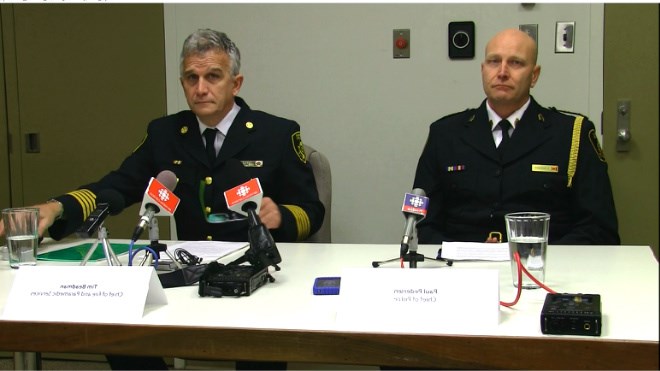They were in response to problems with the 911 response to a serious boating accident on Lake Wahnapitae on June 30, 2013. Stephanie Bertrand, 25, and Matthew Humeniuk, 33, died as a result of injuries from a boating accident. Michael Kritz, 34, was killed when the incident's only survivor, Rob Dorzek, lit a signal fire that accidentally burned the boat.
A 911 dispatcher told Dorzek to start the fire to help emergency responders locate the scene, despite the fact he had sent a GPS map of where they were located. The dispatcher was not able to track the boat's location, which delayed help to the scene for an hour after the initial call for help.
Pedersen said all staff are now trained in GPS locator technology, as well as how to receive information from different types of cellphones.
“They can now receive texts and photos through cellphones,” he said. “They can actually instruct the public on how to turn on how to turn on the GPS location on the person's mobile device.
“That training has been provided through our cybercrime unit to both 911 and central ambulance communicators on cellphone awareness and cellphone technology.”
They have also created a training video, which is available to the public, as well as EMS staff.
Beadman said the emergency call they received in June 2013 was complex, particularly because it was in a remote location late at night. As part of efforts to improve their ability to respond in future, training exercises will be conducted in similarly challenging circumstances.
For safety reasons, he said the training has traditionally been conducted during in daytime. He said work on another recommendation – creating a single call centre that can dispatch police, fire and ambulance services – has been underway for the last couple of years, and a business plan will go to city council in the new year.
Currently, fire and police operate out of a single call centre in the downtown police station, but provincial ambulance services operate from a separate facility. Getting the province to agree to centralizing the calls is the next step.
“Our target is as soon as we can, but hopefully within 2015,” he said, when asked when the three services will operate from a single call centre.
“We are, no doubt, in a better position today to respond to these unique and difficult circumstances and have improved our collective abilities to work together on incidents of this nature,” he said.
They're also creating a central list of lakes, rivers, parks, trails, recreation areas in remote areas, a list available resources -- such as rescue boats and ATVs -- along with emergency staging areas, information that would be available to responding EMS staff.
The work is being done through the Joint Emergency Services Operations Group (JESOG), a body created in June to ensure all groups involved in responding to emergencies can communicate better and co-ordinate their response.
“The primary purpose of JESOG is to address the interoperability of emergency services in their collective abilities to respond to these types of emergency incidents,” Pedersen said.
And he said all emergency responders have embraced another recommendation – to provide support to staff after a traumatic incident.
“And we are continually reviewing best practices in this area,” he said.
Both men addressed the families of the victims and promised that the tragic loss they endured will lead to changes in the system.
“We offer our most heartfelt condolences,” Pedersen said. “You reached out to emergency services through 911, and we know we need to implement the recommendations outlined, as part of our commitment to continuous improvement.”
He said EMS staff field 60,000 calls a year, including 35,000 calls going to 911. While perfection is hard to achieve, he said that is their goal.
“Calls like this, which originate from remote locations, in adverse conditions, present unique and unusual challenges and push our resource capabilities, and this is precisely why these lessons learned have been incorporated into these recommendations,” Pedersen said. “There are things that we are now doing differently. The public should have continued confidence in the 911 system.”
Join Sudbury.com+
- Messages
- Post a Listing
- Your Listings
- Your Profile
- Your Subscriptions
- Your Likes
- Your Business
- Support Local News
- Payment History
Sudbury.com+ members
Already a +member?
Not a +member?
Sign up for a Sudbury.com+ account for instant access to upcoming contests, local offers, auctions and so much more.
